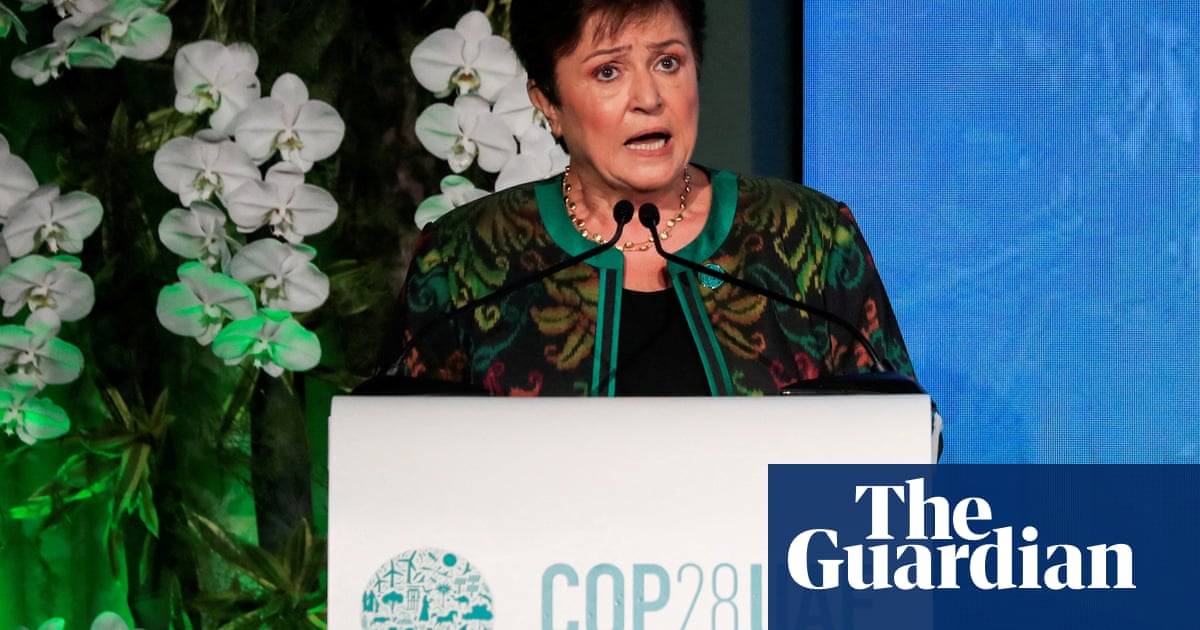
Diverting the trillions of dollars by which the world subsidises fossil fuel production each year, and putting an implicit price on carbon emissions, would generate the vast amounts of cash needed to tackle the climate crisis, the head of the International Monetary Fund has said.
Governments have been put off explicitly pricing carbon by the potential unpopularity of new carbon taxes, which have become favourite targets of anti-climate politicians and parties around the world, from the US and Australia to Europe and the UK.
Kristalina Georgieva, the managing director of the IMF, said it was possible to achieve the same result – of making high-carbon activities reflect their true costs to society – using regulation, and by cutting the bad subsidies that encourage fossil-fuel use.
“We have been slow on a very important policy thought, which is the incentive for investors by still tolerating high levels of fossil-fuel subsidies,” she told the Guardian in an interview. “And [the world has made this worse] by being still fairly slow on introducing carbon pricing, and giving a trajectory for this carbon price upward.”
When you put a price on carbon, decarbonisation accelerates
Kristalina Georgieva, of the IMF
Monday was finance and trade day at the UN Cop28 climate summit in Dubai, with governments, finance institutions and private sector investors discussing new initiatives to help find the trillions needed to shift the world to a low-carbon economy. There were few substantial announcements of new cash, however, as most governments had made their contributions to the loss and damage fund, now standing at around $700m (£556m), in the first week of the conference.
Studies by prominent economists have shown that trillions are needed around the world each year in investment in renewable energy and other low-carbon technology – for instance, Lord Nicholas Stern and Vera Songwe found that developing countries alone, excluding China, will need more than $2tn (£1.6tn) a year by 2030, to cut emissions and cope with the impact of extreme weather. These sums seem huge, but are relatively small in the context of a global economy that is worth about $450tn (£358tn).
This summer, the IMF calculated that the direct and indirect subsidies that go towards fossil fuels, even without counting proven impacts such as health costs, had reached more than $7tn (£5.56tn), driven to record levels by governments’ reactions to the cost of living crisis.
Reforming these would release resources that could be poured into renewable energy and other low-carbon technologies, stimulating the market for “clean” growth, said Georgieva. On the “flip side”, she added, putting in place a carbon price would penalise high-carbon investment.
Economists have argued for decades that pricing carbon is the most effective way to lead economies to a shift away from fossil fuels. “The evidence is first it works,” said Georgieva, a former chief executive of the World Bank and a leading European commissioner, before she took on her current role in 2019. “When you put a price on carbon, decarbonisation accelerates. The Europeans introduced the emission trading scheme [in 2005] and they have been growing and yet emissions went down by 37%. You see the same thing in Canada with their carbon tax.”
Carbon taxes and emissions trading can also generate revenues for governments. “When we talk about the need to support the transition to the green economy, where the money could come from – well, here is the source,” she said.
It is not so easy to identify the carbon content and then to put on an appropriate price
Kristalina Georgieva
Pricing carbon was also fair, she said, as the more companies or individuals contribute to the climate crisis, the more they would pay.
However, attractive though a carbon price may be in economic theory, in practice governments are reluctant to impose such explicit prices and taxes, because they can easily be attacked, and because they hit poorer people hardest, if badly applied. The gilets jaunes protests in France, for instance, were sparked by fuel taxes, and carbon-pricing proposals in the US and Australia were abandoned after sustained attacks from the right wing.
“It is not likely that we will go to pricing carbon everywhere immediately, because it is not so easy to identify the carbon content and then to put on an appropriate price,” Georgieva conceded.
She said governments could use regulation instead. Specifying minimum levels of efficiency, legislating to phase out high-carbon goods – such as the UK’s 2035 ban on sales of new diesel and petrol cars – and forcing industries to higher standards, like enforcing building regulations for new and refurbished homes, are all ways in which governments can make high-carbon activities more expensive.
“When we talk about carbon prices, the perfect should not be an enemy of the good. Yes, the best way to introduce implement carbon prices [is] a carbon tax,” she said. “But it is not politically feasible in some countries … We can also use regulatory compliance in which standards lead to implicit prices on carbon.”
She said the IMF, World Bank, OECD and World Trade Organization had set up a taskforce to examine the different carbon prices that are implied in countries around the world by their carbon policies and regulations.
This could come in useful if countries pursue “carbon border adjustment mechanisms”, as the EU is doing, which penalise imports from countries with lax environmental regulations. “[The taskforce will look at] how we can offer equivalency of these different ways in which to price carbon, so there could be fairness and countries can accept that there is a level playing field,” she said.












